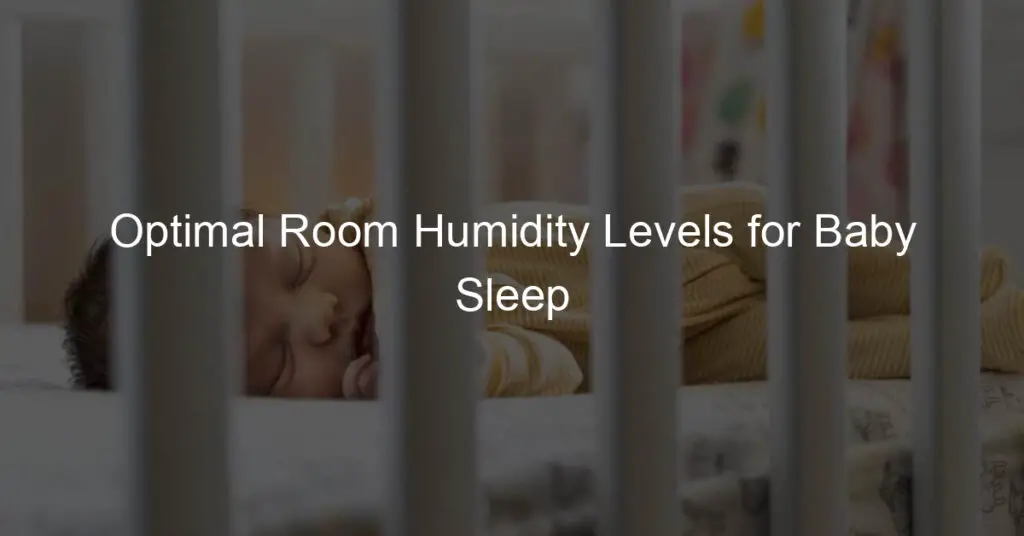This blog post discusses the optimal room humidity levels for a baby’s sound sleep. It explores the importance of maintaining an ideal humidity level, its impact on the baby’s health and well-being, and provides practical tips on how to achieve and maintain the perfect humidity level.
Understanding the Importance of Optimal Room Humidity
Maintaining optimal room humidity is crucial for creating a comfortable and healthy sleep environment for your baby. Humidity refers to the amount of moisture present in the air, and it plays a significant role in the overall well-being of your little one.
Proper room humidity helps prevent dryness in the air, which can lead to a variety of discomforts for your baby, such as dry skin, irritated nasal passages, and even respiratory problems. On the other hand, excessive humidity can promote the growth of mold, dust mites, and other allergens that may trigger allergies or respiratory issues.
By understanding the importance of optimal room humidity, you can take the necessary steps to provide your baby with a sleep environment that promotes their health and well-being. Maintaining a balanced humidity level can help prevent common discomforts and ensure that your baby gets a good night’s sleep.
Moreover, optimal room humidity can also help regulate body temperature. When the air is too dry, it can cause the body to lose moisture rapidly, leading to dehydration and discomfort. Conversely, excessively humid air can make it difficult for the body to cool down, leading to excessive sweating and discomfort.
In addition to physical well-being, room humidity also affects the quality of sleep. When the air is too dry, your baby may experience difficulty breathing or a dry throat, leading to disrupted sleep. Balanced humidity levels can help ensure that your baby sleeps comfortably throughout the night, promoting better sleep patterns and overall sleep quality.
What is the Ideal Room Humidity Level for Baby’s Sleep?
The ideal room humidity level for a baby’s sleep is typically between 40% and 60%. This range ensures that the air is neither too dry nor too humid, creating a comfortable and optimal sleep environment.
When the air is too dry, it can cause dryness in your baby’s skin, nasal passages, and throat. This can lead to discomfort, irritation, and difficulty breathing, ultimately disrupting their sleep. On the other hand, excessively high humidity levels can create a breeding ground for mold, dust mites, and other allergens, which can trigger allergies or respiratory problems.
Maintaining a humidity level between 40% and 60% helps to prevent these issues and promotes better sleep for your baby. The moisture in the air helps keep their skin hydrated, their nasal passages clear, and their respiratory system functioning properly.
To ensure that you are maintaining the ideal humidity level in your baby’s room, it is recommended to use a hygrometer, which measures the humidity in the air. This allows you to monitor the levels and make adjustments if necessary.
It’s important to note that the ideal humidity level may vary depending on the climate and season. In colder months, when the heating system is in use, the air tends to be drier, so using a humidifier can help maintain the optimal humidity level. In more humid climates or during the summer, using a dehumidifier may be necessary to reduce excess moisture in the air.
How Does High Humidity Affect Baby’s Sleep?
High humidity can have a negative impact on your baby’s sleep quality and overall well-being. Let’s explore three key ways in which high humidity affects your baby’s sleep:
- 1. Discomfort and Restlessness:
When the humidity levels are high, the air feels heavy and damp, causing your baby to feel uncomfortable. Excessive moisture in the air can make it difficult for them to breathe properly, leading to restlessness and tossing and turning during sleep. This discomfort can disrupt their sleep patterns and result in frequent awakenings throughout the night.2. Increased Risk of Allergies and Respiratory Issues:
High humidity creates an ideal environment for the growth of mold, dust mites, and other allergens. These allergens can trigger respiratory problems and allergies in babies, such as wheezing, coughing, and congestion. Continuous exposure to high humidity can increase the risk of developing respiratory issues, making it harder for your baby to breathe comfortably while sleeping. - 3. Skin Irritation and Rashes:
Excessive moisture in the air can also lead to skin irritation and rashes in babies. High humidity can cause sweat to linger on the skin, leading to irritation and discomfort. This can result in itchy skin, rashes, and even diaper rash. These skin irritations can be quite bothersome for your baby, making it difficult for them to settle down and have a restful sleep.
Is Low Humidity Also a Problem?
Low humidity can indeed be a problem for your baby’s sleep and overall health. Let’s explore three key reasons why low humidity can have a negative impact:
- 1. Dry Air and Respiratory Issues:
When the humidity levels are too low, the air becomes dry. This dry air can irritate your baby’s respiratory system, leading to discomfort and potential breathing difficulties. Dry air can cause dry nasal passages, throat, and lungs, making it harder for your baby to breathe properly while sleeping. This can result in snoring, coughing, and even increased susceptibility to respiratory infections. - 2. Skin Dryness and Irritation:
Low humidity can also cause your baby’s skin to become dry and itchy. The lack of moisture in the air can lead to dry skin, chapped lips, and even eczema flare-ups. Dry skin can be uncomfortable for your baby and may disrupt their sleep as they may feel the need to scratch or rub their skin. It is important to keep their skin moisturized and hydrated to alleviate any discomfort caused by low humidity. - 3. Increased Risk of Dehydration:
In a low-humidity environment, moisture evaporates from the body more quickly. This means that your baby may lose moisture through their skin and respiratory system at a faster rate than usual. This increased rate of moisture loss can potentially lead to dehydration if your baby is not adequately hydrated. Dehydration can cause various health issues and can negatively impact your baby’s sleep quality.
Signs Your Baby’s Room Has Incorrect Humidity Levels
It is crucial to be aware of the signs that indicate your baby’s room has incorrect humidity levels. Here are some key indicators to look out for:
- 1. Excessive Dryness:
If you notice that your baby’s skin feels excessively dry or their lips appear chapped, it could be a sign that the room’s humidity levels are too low. Dryness can also extend to their nasal passages, causing discomfort and potential breathing difficulties. - 2. Increased Congestion:
On the other hand, if your baby seems to be experiencing nasal congestion or respiratory issues more frequently, it may indicate that the room’s humidity levels are too high. Excess moisture in the air can contribute to the growth of mold, mildew, and dust mites, which can trigger allergies and worsen respiratory conditions. - 3. Difficulty Sleeping:
Incorrect humidity levels can disrupt your baby’s sleep patterns. If your baby is having trouble falling asleep or staying asleep, it’s worth considering whether the room’s humidity levels are contributing to their restlessness. High humidity can make the room feel stuffy and uncomfortable, while low humidity can lead to dryness and discomfort. - 4. Skin Irritation and Eczema Flare-Ups:
If your baby’s skin is experiencing frequent irritation, redness, or eczema flare-ups, it could be a sign that the room’s humidity levels are not optimal. Both high and low humidity can contribute to skin dryness and sensitivity, leading to these skin issues. - 5. Allergy Symptoms:
Pay attention to any allergy symptoms your baby may be exhibiting. If they are sneezing, coughing, or experiencing watery eyes frequently, it may be a sign that the room’s humidity levels are not balanced. High humidity can promote the growth of allergens, such as mold and dust mites, while low humidity can cause dryness and irritation in the respiratory system.
How to Measure Room Humidity?
There are several methods you can use to measure the humidity levels in your baby’s room. Here are three commonly used techniques:
- 1. Hygrometer:
A hygrometer is a device specifically designed to measure humidity levels. It is a small and portable instrument that provides accurate readings. There are different types of hygrometers available, including analog and digital options. Simply place the hygrometer in your baby’s room and wait for it to display the current humidity level. Ensure that the hygrometer is positioned away from direct sources of moisture, such as windows or humidifiers, to obtain an accurate reading. - 2. Indoor Weather Station:
An indoor weather station is a comprehensive device that not only measures humidity but also provides information on temperature, air quality, and more. These stations typically consist of multiple sensors that monitor various environmental factors. They often come with a central display unit that shows real-time data. By investing in an indoor weather station, you can easily track the humidity levels in your baby’s room and make necessary adjustments. - 3. Smartphone Apps:
In today’s digital age, there are numerous smartphone apps available that can measure and monitor room humidity. These apps utilize the built-in sensors in your phone to provide humidity readings. Simply download a reputable humidity app from your app store, open it, and follow the instructions to measure the humidity in your baby’s room. However, it’s important to note that while smartphone apps can provide a rough estimate of humidity levels, they may not be as accurate as dedicated hygrometers or weather stations.
How to Increase Humidity in the Room?
If you find that the humidity levels in your baby’s room are too low, there are several effective methods you can use to increase the moisture in the air. Here are a few strategies to consider:
- 1. Use a Humidifier:
One of the most common and convenient ways to increase humidity is by using a humidifier. These devices emit water vapor into the air, effectively raising the moisture levels. There are different types of humidifiers available, including cool-mist and warm-mist options. Cool-mist humidifiers are generally recommended for baby’s rooms as they don’t pose a risk of burns. Ensure that you clean and maintain the humidifier regularly to prevent the growth of mold or bacteria. - 2. Place Water Containers:
Another simple and cost-effective method to increase humidity is by placing water containers around the room. You can use bowls, pans, or even decorative containers filled with water. As the water evaporates, it adds moisture to the air. For best results, place the containers near heat sources, such as radiators or vents, to speed up the evaporation process. Remember to regularly refill the containers to ensure a continuous source of moisture. - 3. Hang Damp Towels:
If you’re looking for a quick fix, hanging damp towels in the room can provide temporary moisture. Wet a towel with warm water, wring out the excess, and then hang it up in the room. As the water evaporates from the towel, it will increase the humidity levels. However, be cautious not to hang towels near any electrical equipment to avoid any safety hazards. - 4. Open Bathroom Door:
When showering or bathing, leave the bathroom door open to allow the steam to escape into the surrounding areas. The steam from the hot water will increase the humidity in the adjacent rooms, including your baby’s room. However, ensure that the bathroom door is closed properly after the bathing session to prevent any potential accidents.
How to Reduce Humidity in the Room?
If you find that the humidity levels in your baby’s room are too high, it is important to take steps to decrease the moisture in the air. Excessive humidity can lead to discomfort, promote the growth of mold and mildew, and potentially affect your baby’s sleep. Here are some effective methods to help decrease humidity in the room:
- 1. Use a Dehumidifier:
A dehumidifier is a device designed to remove excess moisture from the air. It works by drawing in humid air, cooling it to condense the moisture, and then releasing the dry air back into the room. Place the dehumidifier in the room and adjust the settings according to the manufacturer’s instructions. Empty the water tank regularly to ensure optimal functioning. - 2. Ventilate the Room:
Proper ventilation is crucial in reducing humidity levels. Open windows and doors to allow fresh air to circulate throughout the room. You can also use fans to facilitate air movement. Additionally, consider using exhaust fans in areas where moisture is generated, such as the bathroom or kitchen, to expel humid air directly outside. - 3. Fix Leaks and Seal Cracks:
Water leaks and cracks in walls or windows can contribute to high humidity levels. Inspect the room for any signs of leaks or moisture intrusion. Fix any leaks promptly and seal any cracks to prevent excess moisture from entering the room. - 4. Limit Water Usage:
Be mindful of activities that generate moisture, such as boiling water, using the dishwasher, or running hot showers. Limiting these activities can help reduce humidity levels. Opt for cooler showers, use the dishwasher sparingly, and cover pots while cooking to minimize steam production. - 5. Use Moisture Absorbers:
Moisture absorbers, such as silica gel packs or desiccants, can help remove excess moisture from the air. Place these packs in areas prone to high humidity, such as closets or near windows. Remember to keep them out of your baby’s reach.
Benefits of Using a Humidifier in Baby’s Room
Using a humidifier in your baby’s room can provide numerous benefits for their sleep and overall well-being. Here are some advantages of incorporating a humidifier into your baby’s sleep environment:
- 1. Relieves Dryness:
Humidifiers add moisture to the air, which helps alleviate dryness in the room. This can be particularly beneficial during the winter months when indoor heating systems tend to dry out the air, leading to dry skin, irritated nasal passages, and dry coughs. A humidifier can help maintain a comfortable level of moisture, reducing these discomforts for your baby. - 2. Eases Congestion:
If your baby experiences congestion due to a cold, allergies, or dry air, a humidifier can help relieve their nasal congestion and improve their breathing. The added moisture in the air helps to loosen mucus and soothe irritated nasal passages, making it easier for your baby to breathe and sleep more comfortably. - 3. Prevents Dry Throat and Lips:
Dry air can also cause your baby to wake up with a dry throat and chapped lips. A humidifier can help combat this by increasing the moisture in the room, preventing these discomforts and promoting a more restful sleep. - 4. Reduces Static Electricity:
Dry air can lead to an increase in static electricity, resulting in small shocks when touching objects or other people. By using a humidifier, you can help reduce the static electricity in the room, creating a more pleasant and safe environment for your baby. - 5. Promotes Healthy Skin:
Dry air can cause your baby’s skin to become dry, itchy, and prone to irritation. A humidifier helps to maintain the moisture balance in the air, preventing excessive dryness and promoting healthier skin. This can be especially beneficial for babies with sensitive skin or conditions such as eczema.
Can Dehumidifiers Help in Maintaining Optimal Humidity Level?
Dehumidifiers play a crucial role in maintaining the optimal humidity level in your baby’s room. Here are some ways in which dehumidifiers can be beneficial:
- 1. Controlling Excess Moisture:
Dehumidifiers are designed to remove excess moisture from the air, making them effective in reducing high humidity levels. If your baby’s room tends to feel damp or has a musty odor, a dehumidifier can help eliminate these issues by extracting the excess moisture from the air. - 2. Preventing Mold and Mildew:
High humidity can create a favorable environment for the growth of mold and mildew, which can be harmful to your baby’s health. Dehumidifiers help to lower the humidity, making it less likely for mold and mildew to thrive. This is particularly important in areas with high humidity or if your baby’s room has poor ventilation. - 3. Improving Air Quality:
Excess humidity can lead to the accumulation of dust mites, allergens, and other pollutants in the air. Dehumidifiers help to reduce these contaminants by creating a drier environment. This can be especially beneficial for babies with respiratory conditions or allergies, as it helps to improve the overall air quality in their room.It is important to note that using a dehumidifier should be done with caution, as extremely low humidity levels can also have adverse effects. It is recommended to maintain a humidity level between 40-50 percent for optimal comfort and health. It is advisable to monitor the humidity levels regularly using a hygrometer to ensure they remain within the desired range.
Additionally, it is crucial to regularly clean and maintain the dehumidifier to prevent the growth of mold or bacteria within the unit. Following the manufacturer’s instructions for cleaning and emptying the water reservoir will help maintain the effectiveness and safety of the dehumidifier.
Natural Ways to Control Room Humidity
If you prefer to take a more natural approach to control room humidity, there are several methods you can try. First, proper ventilation is key in maintaining the optimal humidity level. Opening windows and using fans can help circulate the air and prevent moisture buildup. Additionally, using breathable fabrics for curtains and bedding can allow for better airflow.
Plants can also play a role in regulating humidity levels. Certain plants, such as Boston Ferns and Areca Palms, are known for their ability to naturally add moisture to the air through transpiration. Placing a few of these plants in your baby’s room can help maintain a balanced humidity level.
Using a dehumidifying agent, such as calcium chloride, can also be effective in absorbing excess moisture. These agents come in the form of crystals or pellets and can be placed in containers or pouches around the room. They work by attracting and trapping moisture from the air.
Another natural method is to use natural desiccants, such as activated charcoal or silica gel packets. These substances can help absorb excess moisture in the air. Just make sure to keep them out of reach of your baby, as they can be harmful if ingested.
Finally, adjusting daily routines and habits can contribute to controlling room humidity. For example, taking shorter showers, hanging wet clothes outside to dry, and using an exhaust fan while cooking can help prevent excess moisture from entering the air.
How to Maintain the Optimal Humidity Level?
To maintain the optimal humidity level in your baby’s room, there are a few key steps you can follow. First, make sure to regularly monitor the humidity levels using a hygrometer. This device will provide you with accurate readings and help you determine if any adjustments need to be made.
Once you have identified the current humidity level, you can take appropriate action to maintain it. If the humidity is too high, you can use a dehumidifier to remove excess moisture from the air. Place the dehumidifier in the room and set it to the desired humidity level. It will automatically adjust and maintain the optimal conditions.
On the other hand, if the humidity is too low, using a humidifier can help add moisture to the air. There are various types of humidifiers available, such as evaporative, ultrasonic, and steam humidifiers. Choose one that suits your needs and follow the manufacturer’s instructions for proper usage.
Additionally, regular cleaning and maintenance of the humidifier or dehumidifier is essential. This will ensure that they are functioning effectively and not harboring any bacteria or mold that could be harmful to your baby’s health. Follow the manufacturer’s guidelines for cleaning and changing filters, and make it a part of your routine.
In addition to using humidity-controlling devices, it’s important to consider other factors that can affect the humidity in the room. For example, keeping doors and windows properly sealed can prevent moisture from entering or escaping. Proper insulation can also help maintain consistent humidity levels.
Is it necessary to monitor humidity levels regularly?
Yes, it is necessary to monitor humidity levels regularly in your baby’s room. Humidity plays a crucial role in maintaining a comfortable and healthy environment for your little one to sleep in. By monitoring the humidity levels, you can ensure that they are within the optimal range for your baby’s well-being.
Regular monitoring allows you to identify any fluctuations or deviations from the desired humidity level. This is particularly important because humidity levels can change throughout the day or due to external factors such as weather conditions.
By keeping a close eye on the humidity levels, you can take prompt action to make adjustments if necessary. For instance, if the humidity is too high, it can create a breeding ground for mold, bacteria, and dust mites, which can lead to respiratory issues and allergies for your baby. On the other hand, low humidity can cause dryness and discomfort, leading to skin irritations and breathing difficulties.
Monitoring humidity levels also helps you ensure that any devices used to control humidity, such as humidifiers or dehumidifiers, are functioning correctly. It allows you to detect any malfunctions or maintenance needs, ensuring that these devices are providing the desired effect.
Furthermore, monitoring humidity levels can help you determine if additional measures are needed to maintain optimal humidity levels. For example, during the dry winter months, you may need to use a humidifier in addition to your regular efforts.
Optimal Room Humidity Levels for Baby Sleep:
| Room Humidity Level | Temperature | Impact on Baby’s Health | Maintaining Ideal Humidity Level |
|---|---|---|---|
| 20-60% | 68-72°F | Reduced risk of infection, improved sleep quality, better breathing | Use a humidifier, ensure proper ventilation |
| 60-70% | 70-78°F | Reduced risk of infection, improved sleep quality, better breathing | Use a humidifier, ensure proper ventilation |
| 50-60% | 68-72°F | Reduced risk of infection, improved sleep quality, better breathing | Use a humidifier, ensure proper ventilation |
| 40-50% | 68-72°F | Reduced risk of infection, improved sleep quality, better breathing | Use a humidifier, ensure proper ventilation |
Maintaining the optimal room humidity level is crucial for your baby’s health, comfort, and sleep quality. It helps prevent various health issues and promotes a good night’s sleep. By using humidifiers, dehumidifiers or natural methods to control the humidity level, you can provide a conducive sleep environment for your baby.














